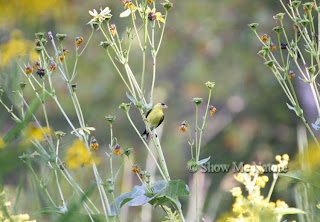There are still a few summer birds on the prairie, but most of them have left. An Indigo Bunting fussed at me as I walked.

It is difficult to determine if this is a female or a young Bunting. Adult male Indigo Buntings are a rich blue color, while their female and young counterparts are brown.
The American Goldfinches are abundant on the prairie right now.
They are busy eating the seeds from the Coneflowers, Cup Plants and the myriad of other flowering plants living on the prairie.
The bees are busier than ever collecting pollen, the cicadas are singing in the trees, butterflies flit from flower to flower and dragonflies dance across the sky.

A dragonfly can spend up to 5 years of its life as a nymph. The nymph form looks completely different from the adult form and lives in a completely different habitat - water. While the adult dragonfly is flying in the air, the nymph is developing underwater. Both the nymph and adult dragonflies eat mosquitoes, midges and other small bothersome insects.
The prairie is awash in yellow right now.
Sweet Coneflower (Rudbeckia subtomentosa) are the beautiful flowers responsible for the prairie's sunny color.
These moist-loving plants can be found in prairies, savannahs, thickets, floodplain forests, woodland borders, roadside ditches and riverbanks. Bloom time begins in July and lasts all the way through late fall.
Ironweed is also in bloom right now. Ironweed is in the asteraceae (daisy) family and there are many species of this plant in Missouri.
Ironweed can tolerate both wet and dry habitats and is found in prairies, meadows, fields, glades, dry woodland and along railroad tracks. They grow 3 - 5 feet in height and bloom July - September. The name Ironweed refers to the tough stems that are often difficult to dig up, and the flowers producing rust colored seeds. This plant is sometimes thought of as a weed because of its propensity to grow abundantly in fields and pastures.
Life may seem to be slowing down on the prairie, but this habitat is active year round. We'll see what is happening on the prairie next month.




No comments:
Post a Comment